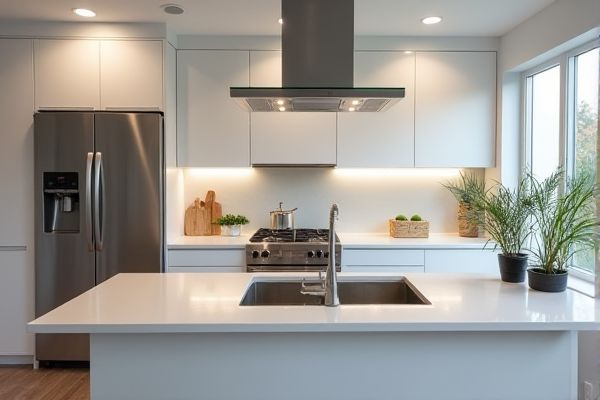
White appliances offer a classic, clean look that brightens kitchens and pairs well with various decor styles, while stainless steel appliances provide a modern, sleek appearance known for durability and easy maintenance. Explore the rest of this article to discover which option best fits your kitchen design and lifestyle needs.
Table of Comparison
| Feature | White Appliances | Stainless Steel Appliances |
|---|---|---|
| Appearance | Classic, clean, bright | Modern, sleek, high-end |
| Durability | Prone to chipping and staining | Resistant to rust, stains, and scratches |
| Maintenance | Easy to clean, hides fingerprints | Shows fingerprints, needs frequent polishing |
| Cost | Generally more affordable | Typically higher price point |
| Versatility | Matches vintage and traditional styles | Fits modern and contemporary kitchens |
| Resale Value | Lower attraction for buyers | Increases kitchen resale appeal |
Introduction to White and Stainless Steel Appliances
White appliances offer a classic and clean aesthetic that complements traditional and farmhouse kitchen designs, providing a bright and timeless look. Stainless steel appliances are favored for their modern, sleek appearance, durability, and resistance to fingerprints and smudges, making them a popular choice for contemporary kitchens. Both options vary in cost, maintenance, and style impact, influencing homeowners' decisions based on kitchen decor and personal preference.
Aesthetic Appeal: Classic White vs. Modern Stainless Steel
White appliances offer a timeless, classic aesthetic that brings a clean and bright look to kitchens, complementing traditional and farmhouse styles seamlessly. Stainless steel appliances feature a sleek, modern appearance with a reflective finish that enhances contemporary and minimalist designs, adding a professional and high-end feel. Your choice between white and stainless steel will significantly influence the overall atmosphere and visual appeal of your kitchen space.
Durability and Maintenance Considerations
White appliances offer durable finishes that resist chipping and fading, making them easy to maintain over time with simple cleaning methods. Stainless steel appliances provide superior resistance to heat and corrosion, but they require regular polishing to prevent fingerprints and smudges from diminishing their sleek appearance. Your decision may depend on whether you prioritize low-maintenance durability or a modern, stain-resistant look that demands more upkeep.
Cost Comparison: Budgeting for Kitchen Appliances
White appliances typically cost less upfront than stainless steel options, making them a budget-friendly choice for cost-conscious homeowners. Stainless steel appliances often come with a higher price tag due to their sleek appearance and durable, fingerprint-resistant surface, which may justify the investment over time. When budgeting for kitchen appliances, factoring in both initial costs and long-term maintenance can help determine the best option for balancing aesthetics and affordability.
Fingerprints, Smudges, and Cleaning Ease
White appliances resist fingerprints and smudges better than stainless steel, making them ideal for busy kitchens where cleanliness is crucial. Stainless steel surfaces often show fingerprints and smudges prominently, requiring frequent wiping with specialized cleaners to maintain their sleek appearance. Cleaning white appliances is generally easier with standard household cleaners, while stainless steel demands microfiber cloths and stainless steel-specific products to avoid streaks and preserve shine.
Compatibility with Kitchen Styles and Décor
White appliances offer a classic, clean look that complements traditional and farmhouse-style kitchens, enhancing bright and airy spaces with their neutral tone. Stainless steel appliances provide a sleek, modern appeal that fits well in contemporary, industrial, or minimalist kitchens, reflecting light and coordinating easily with various cabinet finishes. Your choice should align with your kitchen's overall aesthetic, ensuring harmony between appliance finish and decor elements.
Resale Value and Market Trends
Stainless steel appliances consistently boost resale value due to their modern, sleek appearance and widespread consumer preference in the housing market. Market trends indicate a growing demand for stainless steel finishes, reflecting a shift toward contemporary kitchen aesthetics favored by homebuyers. White appliances, while often more budget-friendly and classic, tend to have less impact on resale appeal compared to their stainless steel counterparts.
Energy Efficiency and Technology Features
White appliances often offer comparable energy efficiency to stainless steel models, but stainless steel appliances tend to feature more advanced technology, such as smart connectivity and precision temperature controls. Your choice between white and stainless steel can impact not only the kitchen's aesthetic but also the integration of energy-saving modes and modern functionalities. Prioritizing appliances with ENERGY STAR certification ensures optimal performance regardless of finish.
Installation and Customization Options
White appliances offer versatile installation options and easily blend into traditional or farmhouse kitchen designs, supporting more frequent customization with cabinetry color and style matching. Stainless steel appliances provide sleek, modern installation possibilities, typically favored in contemporary kitchens, and offer superior durability with fewer visible fingerprints and smudges, minimizing maintenance customization. Both types allow for built-in or freestanding placements, but stainless steel often supports advanced tech integration for smart kitchen customization.
Choosing the Right Appliance Finish for Your Home
White appliances offer a classic, clean look that brightens kitchens and pairs well with traditional decor, while stainless steel appliances provide a sleek, modern appearance with durable, fingerprint-resistant surfaces ideal for high-traffic areas. Consider white finishes for a timeless, budget-friendly option that hides smudges and blends seamlessly with light-colored cabinets, whereas stainless steel enhances resale value through its contemporary appeal and easy maintenance. Choosing between these finishes depends on your kitchen style, cleaning preferences, and overall design goals to ensure long-term satisfaction.
 homyna.com
homyna.com